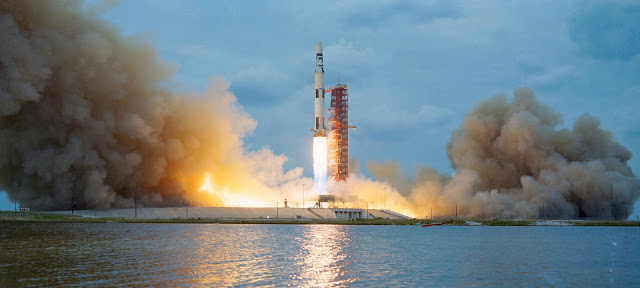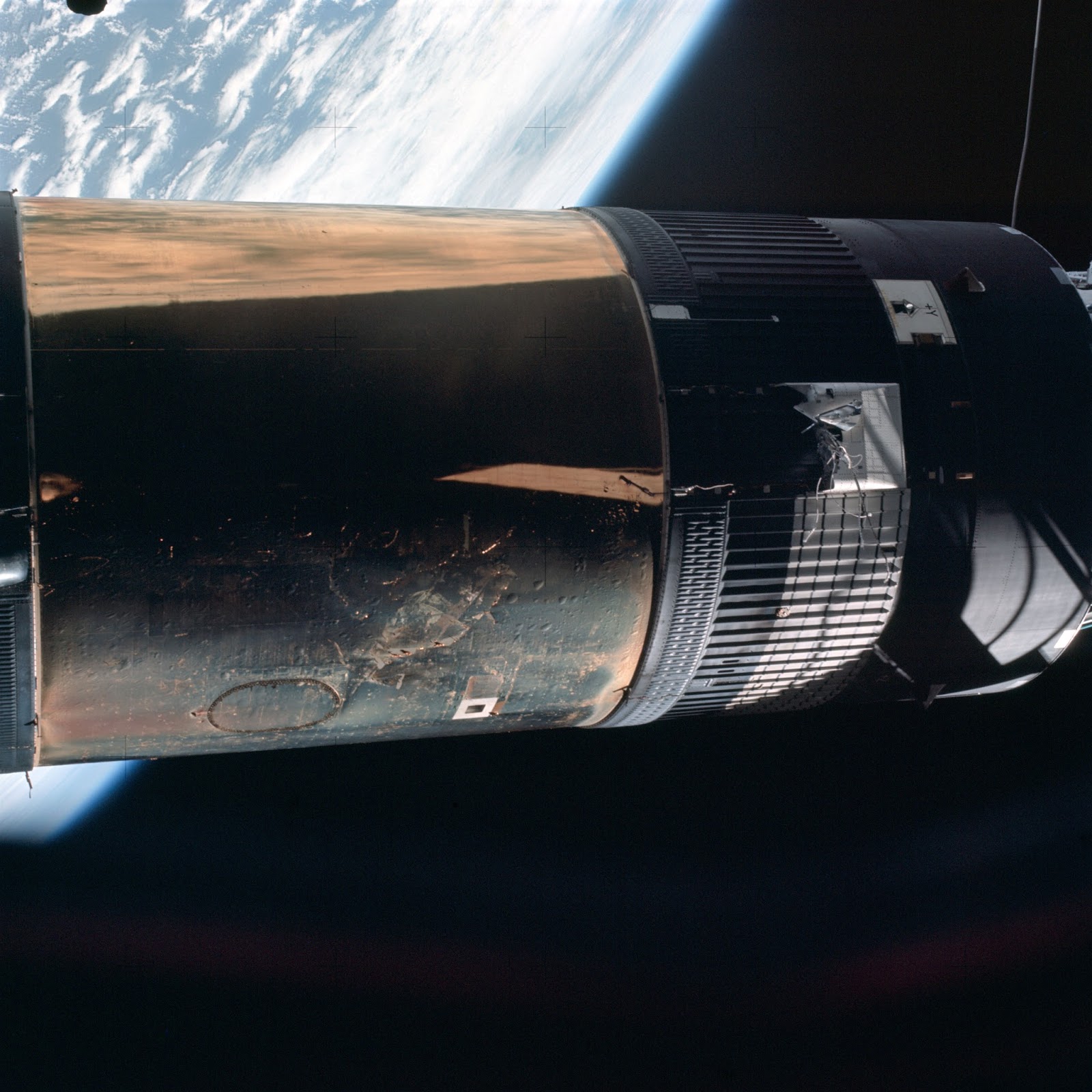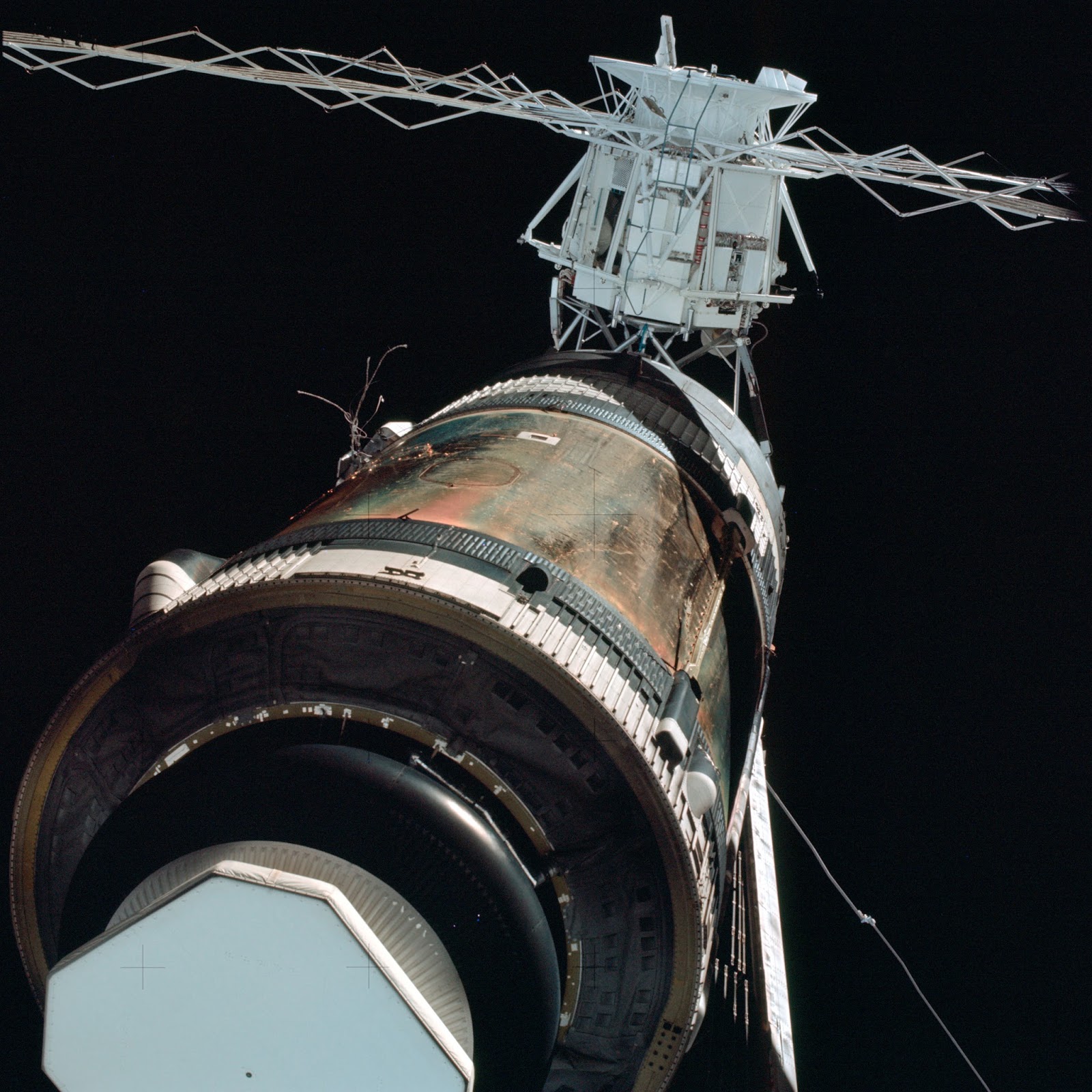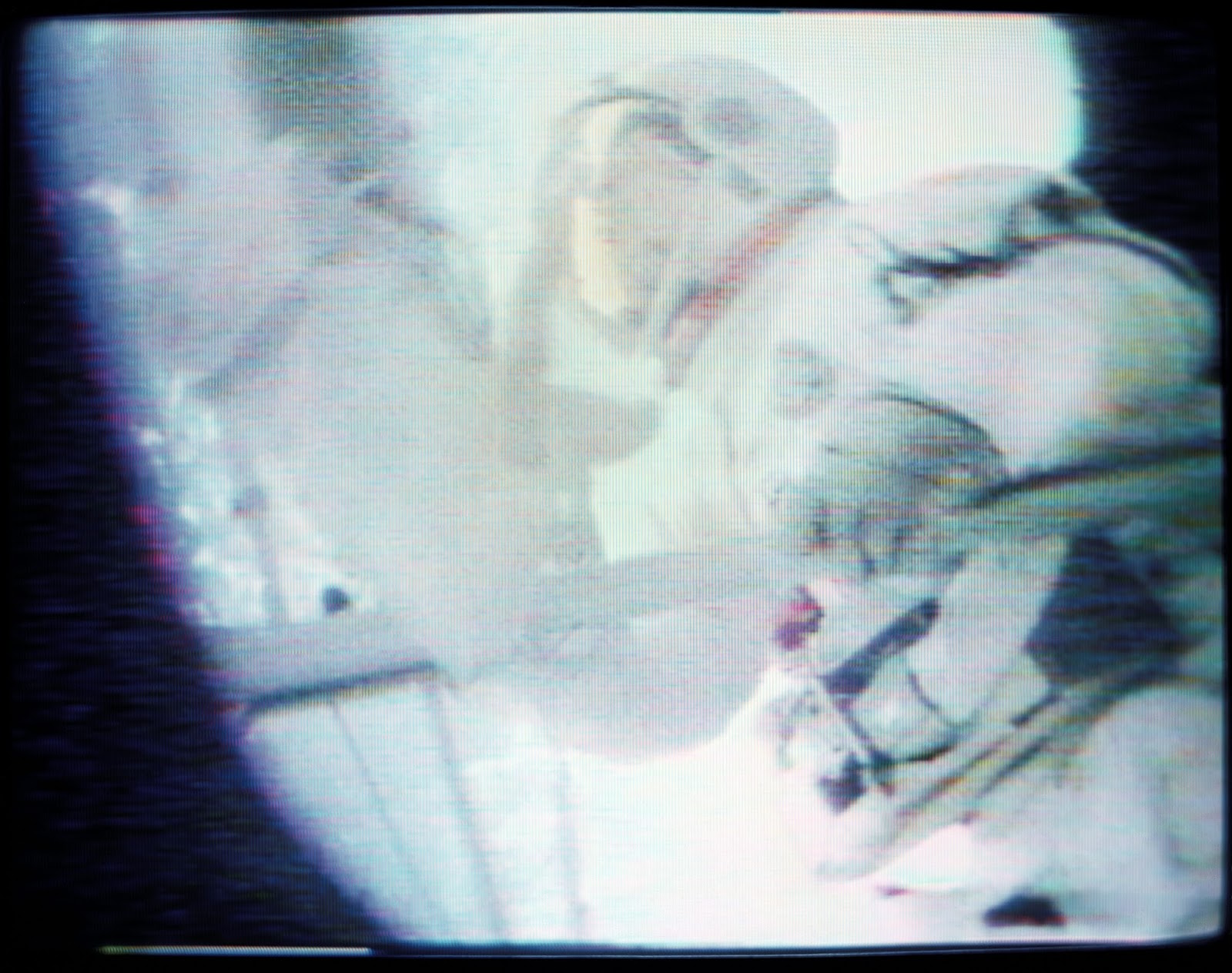 |
| Just seconds before chaos ensues, Skylab’s Saturn V climbs into the skies on May 14th, 1973. NASA photo. |
With rising internal temperatures and a trickle of electrical power, it became apparent shortly after Skylab’s launch on May 14th, 1973 that America’s first space station was in serious trouble. During the Skylab panel at Spacefest VII conducted on June 10th, 2016, astronauts Rusty Schweickart (Skylab 2’s backup commander) and Paul Weitz (Skylab 2’s pilot) discussed the fixes that were required to restore Skylab back to health after it had been severely crippled by several launch anomalies. Schweickart (along with backup crew members Dr. Story Musgrave and Bruce McCandless) devised many of the repairs on Earth, while Weitz valiantly attempted to fix Skylab’s jammed SAS-1 solar wing during a stand-up EVA using a special pair of “bolt cutters” at the beginning of his crew’s mission.
Indeed, the fact that Skylab was able to be salvaged after suffering several disabling blows – the loss of its micrometeroid shield (MS), the complete loss of one solar wing, and the jamming of another – was nothing short of incredible. But how did Skylab acquire these near-fatal wounds? And was there another strange anomaly that could have killed the whole mission? Read further…
It is often reported that the sequence resulting in the loss of the micrometeroid shield and the damage to the solar panels began during Max-Q, the period of maximum aerodynamic pressure. This is NOT true in the case of Skylab’s launch. The sequence of events that nearly doomed Skylab, putting the program in jeopardy, actually started just over a minute after the vehicle left the launchpad on the overcast May morning, as the last Saturn V rocket launched reached Mach 1 (the speed of sound).
The NASA mission reports concerning the launch of Skylab 1 discuss in depth the telemetry data alerting the ground that something terribly wrong had happened during launch. Early indications of problems included an “increase in S-II telemetry reflected power” and noted changes in the positions of the MS torsion rods. The increase in power, which the reports said “might be indicative of a vehicle physical configuration change which altered the antenna ground plane characteristic,” began nearly 60 seconds into the launch.
Shortly after these indicators flagged possible issues with the Skylab cluster, trouble appeared. The mission reports bluntly indicated, “At about 63 seconds, numerous measurements indicated the apparent early deployment and loss of the MS. At this time, the vehicle was at about 28,600 feet altitude and at a velocity of about Mach 1 [emphasis provided by me].” But why did this happen, and what caused these cascading failures?
The book Growing Up With Spaceflight: Project Skylab/ASTP by author Wes Oleszewski also discussedSkylab’s early troubles at length. Oleszewski wrote:
At 62.807 seconds after liftoff, the launch vehicle began to react to an external, abnormal aerodynamic force… Max-Q was a full 10.63 seconds [after Mach 1] into the future and the meteoroid shield would be long gone by then. What really happened was that as the Mach 1 shock wave passed down the vehicle a reverse flow of air along the skin of the vehicle found its way up what was called the Auxiliary Tunnel (a conduit that ran the length of the workshop). Entering through two uncapped stringers at the base of the tunnel, the high pressure air moved up the tunnel and popped the rubber boot at the top. The airflow then got up under the shield structure and propagated a bulge that was just enough to lift the shield more than 2 inches into the slipstream, which was now at Mach 1.05.
This aerodynamic excursion Oleszewski described is what took out the MS, and subsequently loosened both solar panels.
Photos and film footage taken of the launch verify that due to the overcast weather conditions, the vehicle disappeared into a cloud bank shortly before Mach 1. This prevented anyone on the ground from seeing any possible issues with the vehicle, but had anyone been able to view Skylab’s Saturn V clearly, they would havemost likely been able to see the MS being “spit out” somewhere over the Atlantic Ocean.
Myth #2: When The Solar Panel Took Its Leave
Many reports state that the SAS-2 solar panel detached at the same time the micrometeroid shield was torn off, but that is also not the case. The mission reports confirmed that by +593 seconds following the launch, “further preliminary evaluation revealed abnormal vehicle accelerations, vibrations, and SAS temperature and voltage anomalies… [t]emperature data loss and sudden voltage drops indicated that the SAS-2 wing was fully separated from the OWS [orbital workshop] at the time.” Note that +593 seconds is quite a long time after Mach 1 occurred (nearly nine minutes later, to be specific). The two solar panels stayed in place throughout most of the launch sequence, well after the MS had left the vehicle.
So what caused SAS-2 to shear off completely, and SAS-1 to be partially stuck, trickling electricity and resulting in a risky EVA by Skylab 2 commander Pete Conrad and science pilot Dr. Joe Kerwin? Remember, the MS detachment loosened the solar wings. Oleszewski wrote of SAS-2’s death knell:
At S-II shutdown…four solid fuel retro rockets mounted at 90 degree intervals around the S-IVB / S-II forward adapter skirt fired to aid in separation of the S-II from the upper stage. SAS wing number 2 was centered just 16.8 degrees off one of the retro rockets. The plume from that retro’s firing hit the already loose SAS wing and blew it “…completely off the bird” as Pete Conrad later observed.
According to Oleszewski, SAS-1 remained attached to Skylab during this phase of the mission only because it was held down by the MS’ debris.
Wait, There’s More: The MS Took AnotherHostage When It Detached
The rest of the launch was not the definition of “smooth sailing,” either. One largely under-reported incident during Skylab’s launch had the potential to kill the entire station, and perhaps the entire program. The mission reports read, “Post-flight analysis revealed unexpectedly high temperatures and pressures in the S-II engine compartment following ignition and continued high after interstage separation command.”
According to Oleszewski as the MS fell, it hit the Saturn V “at least twice.” The second blow to the rocket had nearly devastating consequences, as Oleszewski reported that “[t]he impact area included the second plane separation point where the linear shaped charge was located that pyrotechnically blows the parts of the airframe apart so that the ‘skirt’ ring can be dropped after first stage separation.” This S-II skirt separation did not occur, and temperatures at the base of the stage unacceptably spiked.
In a comedy of errors, ground controllers were not aware of the skirt stage separation failure due to an erroneous signal propagated by the MS detachment and subsequent vehicle strike. It is surmised the stage was probably seconds away from failure when the S-II’s engines outboard engines shut down, and the space station was within moments of being forever lost. One can never truly know what kind of effect this would have had on the Skylab program, and NASA in general.
Wait, There’s Even More: The Curious Case of the Lead Weights
The Saturn V, devised for the Apollo lunar missions, required some ballast for the Skylab mission in the form of lead weights, according to Jonathan Ward’s book Countdown to a Moon Launch:Preparing Apollo for Its Historic Journey. Why? This was because the Saturn V was a Moon rocket, not a “Skylab” rocket.
According to David Henson, a structural engineer who was interviewed by Ward, “The Skylab launch vehicle’s third stage was modified into a lab, with a docking adapter and the Apollo telescope mount attached above the Skylab. This vehicle configuration was not as heavy as the S-IVB and CSM for an Apollo mission.” The Skylab launch vehicle would have a different, lower center of gravity than one utilized for an Apollo lunar mission. The fix? Blocks of lead were added to the interstage. Really.
What happened to the lead weights? In another comedy of errors, when the S-II interstage failed to separate due to the damage caused by the MS debris strike, it ended up taking itself – and the lead weights – into orbit. This was confirmed by images and video taken by the Department of Defense (in addition, the DoD also confirmed the suspicion that Skylab was missing its MS and one solar wing, and possessed a jammed solar wing). According to Oleszewski’s blog, a gentleman named Tom Faber was able to see not only Skylab, but also four sections of the payload shroud, the S-II (with the weights), and the lost solar panel passing NW to SE over Atlanta shortly following its launch.
Skylab’s “Can-Do” Legacy
Skylab’s launch highlighted that despite many successful Saturn V launches, spaceflight would never be “routine” and “easy” in the slightest. Butdespite all of these early problems, the Skylab story has the best possible resolution. Both the crews and the ground learned how to “improvise, adapt, and overcome,” and fix serious issues whilein orbit.
The first crew erected a replacement sunshade utilizing the station’s scientific airlock, and unjammed SAS-1 in what perhaps was the riskiest spacewalk ever undertaken in NASA’s history. The second crew (commander Alan Bean, pilot Jack Lousma, and science pilot Owen Garriott) would further add to Skylab’srepairs by erecting a twin-pole sunshield. By 1974, three crews had successfully taken residency aboard a “lopsided” but functional space station, sending home valuable medical data, solar physics results, and Earth observations.
Sources/Recommended Reading:
1. Oleszewski, W. (2015). Growing Up With Spaceflight: Project Skylab/ASTP.Washington, D.C.: A Klyde Morris Production.
Emily Carney is a writer, space enthusiast, and creator of the This Space Available space blog, published since 2010. In January 2019, Emily’s This Space Available blog was incorporated into the National Space Society’s blog. The content of Emily’s blog can be accessed via the This Space Available blog category.
Note: The views expressed in This Space Available are those of the author and should not be considered as representing the positions or views of the National Space Society.






















1 thought on “Space Myths Busted: How Skylab Nearly Was Lost”
Nice explanation, I hadn’t realized so much had gone wrong. How on Earth did these people run the Apollo program for the Moon landings and rescue Apollo 13, an almost impossible rescue?
From reading this I determine that a reverse flow of air caused the folded shield to balloon exposing it to external air flow at more than Mach 1 and tearing it from the craft. The shield assembly strikes the explosive device, designed to release the 2nd stage canopy, causing it to remain in place while the 2nd stage fires, in turn causing the craft to overheat. Meanwhile the action of the shield tearing away loosens the solar wing dislodging it sufficiently for the separation thruster to blow it off the craft.
Lead blocks for ballast? Why did they not just throw in a couple of the design technicians, nothing like on the job experience?